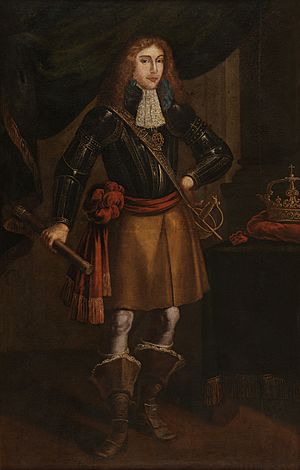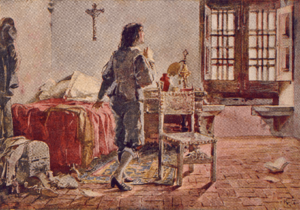Afonso VI of Portugal facts for kids
Quick facts for kids Afonso VI |
|
|---|---|

Portrait in the National Coach Museum
|
|
| King of Portugal | |
| Reign | 6 November 1656 – 12 September 1683 |
| Acclamation | 15 November 1657 |
| Predecessor | John IV |
| Successor | Peter II |
| Regents | Luisa de Guzmán (1656–1662) Peter, Duke of Beja (1668–1683) |
| Chief minister | Count of Castelo Melhor (1662–1667) |
| Born | 21 August 1643 Ribeira Palace, Lisbon, Portugal |
| Died | 12 September 1683 (aged 40) Sintra Palace, Sintra, Portugal |
| Burial | Pantheon of the Braganzas |
| Spouse | |
| House | Braganza |
| Father | John IV of Portugal |
| Mother | Luisa de Guzmán |
| Religion | Roman Catholicism |
Afonso VI (born August 21, 1643 – died September 12, 1683) was the second king of Portugal from the House of Braganza. He was known as "the Victorious" (o Vitorioso). Afonso ruled from 1656 until his death.
At first, his mother, Luisa de Guzmán, was in charge as his regent. But in 1662, Afonso took power himself. He had help from his close friend, the Count of Castelo Melhor. During Afonso's reign, the Portuguese Restoration War ended. Spain finally agreed that Portugal was an independent country. Afonso also made an important alliance with France through his marriage. However, in 1668, his brother Peter II took control of the government. Peter became the regent, meaning he ruled in Afonso's place. Afonso's wife, Maria Francisca of Savoy, later married Peter. Afonso spent the rest of his life as a prisoner.
Contents
Early Life of King Afonso VI
Afonso was the second son of King John IV and Queen Luisa. When he was three years old, he became very ill. This illness caused his right side to be paralyzed. People also thought it affected his ability to think clearly.
In 1653, his older brother, Teodósio, Prince of Brazil, passed away. This meant Afonso became the next in line to the throne. He also received the title of 2nd Prince of Brazil.
Afonso VI's Reign
Afonso became king in 1656 when he was thirteen years old. His father, King John IV, had named Afonso's mother, Luisa de Guzmán, as the regent. This meant she would rule until Afonso was old enough.
Luisa continued to be regent even after Afonso turned an adult. Many people believed he was not mentally ready to govern. In 1662, Afonso decided to take power. He had help from Castelo-Melhor. His mother's time as regent ended, and she moved to a convent.
Afonso made Castelo-Melhor his main advisor. Castelo-Melhor was a very good minister. He organized the army well and chose skilled generals. This led to important victories against Spain. These battles included Elvas (1659), Ameixial (1663), and Montes Claros (1665). These wins helped Portugal gain full independence. Spain finally recognized Portugal's new ruling family, the House of Braganza, in 1668. This was part of the Treaty of Lisbon.
Colonial Changes
During Afonso's rule, Portugal lost some colonies. The Dutch took Jaffna, which was Portugal's last colony in Portuguese Ceylon (1658). Portugal also gave Bombay and Tangier to England in 1661. These places were part of the dowry for Afonso's sister, Catherine of Braganza. She married King Charles II of England.
Royal Marriage
Castelo-Melhor helped arrange Afonso's marriage to Maria Francisca of Savoy in 1666. She was related to the Duke of Savoy. However, the marriage did not last long. Maria Francisca ended the marriage in 1667. After that, she married Afonso's brother, Peter II.
Afonso VI's Downfall

In 1667, Afonso's brother, Peter, gained enough support to take control. Peter forced Afonso to give up governing. Peter became the prince regent in 1668. This meant Peter ruled the country, even though Afonso was still officially the king.
For seven years after Peter took power, Afonso was kept on the island of Terceira in the Azores. His health suffered because of this. Eventually, he was allowed to return to mainland Portugal. But he remained powerless and was kept under guard. Afonso died in 1683 in Sintra. The room where he was held prisoner can still be seen at Sintra National Palace.
Sources
|
Afonso VI of Portugal
Cadet branch of the House of Aviz
Born: 21 August 1643 Died: 12 September 1683 |
||
| Regnal titles | ||
|---|---|---|
| Preceded by John IV |
King of Portugal and the Algarves 1656–1683 |
Succeeded by Peter II |
See also
 In Spanish: Alfonso VI de Portugal para niños
In Spanish: Alfonso VI de Portugal para niños


